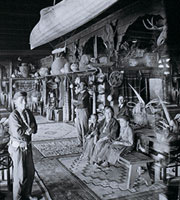After statehood, in 1912, New Mexico began to grow and change more quickly. Politicians, businessmen, artists and archeologists were involved in making decisions about how New Mexico should grow. Tourism was the key to economic development, and the “Santa Fe Plan” was created to promote and maintain a characteristic regional style based on ancient pueblo architecture. The model for this architecture was the mission churches of Acoma and Isleta, and the sculpted adobe masses of Taos Pueblo. The New Mexico Museum of Art and the La Fonda Hotel in Santa Fe, both built by the architectural firm of Rapp and Rapp, first set the example for this type of building. Spanish colonial details such as carved and painted vigas, herringbone patterned latillas, and hand-carved furniture were also incorporated in these buildings. This became known as “Pueblo Spanish Revival” or “Santa Fe Style.”
 The Fred Harvey Company built hotels and train stations with the objective of luring tourists to ride the railroad. The railroad financed the Alvarado Hotel in Albuquerque and the La Fonda Hotel in Santa Fe. The building designs were based on the Pueblo Spanish style, and Mary Colter, the interior designer, incorporated Native American designs, symbols, weavings and traditional artworks into the private rooms and public spaces.
The Fred Harvey Company built hotels and train stations with the objective of luring tourists to ride the railroad. The railroad financed the Alvarado Hotel in Albuquerque and the La Fonda Hotel in Santa Fe. The building designs were based on the Pueblo Spanish style, and Mary Colter, the interior designer, incorporated Native American designs, symbols, weavings and traditional artworks into the private rooms and public spaces.
The first New Mexican architect to invest in and develop the Pueblo Spanish Revival style was John Gaw Meem. Meem was trained as an engineer and came to Santa Fe to receive treatment for tuberculosis. While recovering, he met interesting intellectuals and artists including Carlos Vierra, who photographed and painted all the mission churches in the state. Both Vierra and Meem became key players in an organization dedicated to preserving New Mexico’s mission churches and, in the process, became strong proponents of Santa Fe style architecture.
 Pueblo Deco is a style related Pueblo Spanish revivalist architecture. The Kimo Theater in Albuquerque is an excellent example that combines elegant, simplified Art Deco lines with ornament and decoration based on Native American motifs and designs.
Pueblo Deco is a style related Pueblo Spanish revivalist architecture. The Kimo Theater in Albuquerque is an excellent example that combines elegant, simplified Art Deco lines with ornament and decoration based on Native American motifs and designs.
